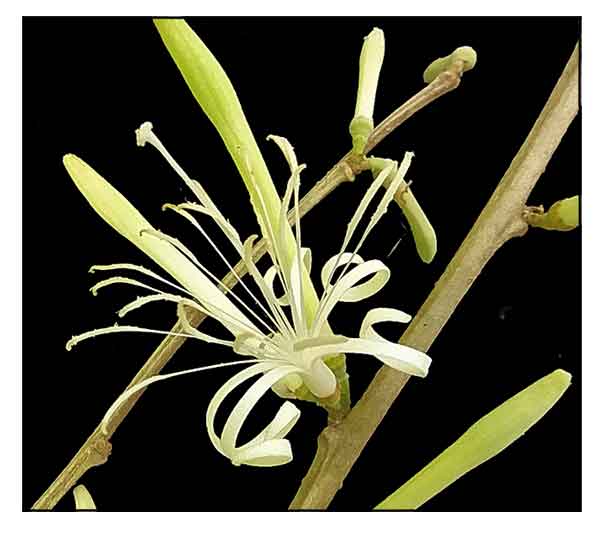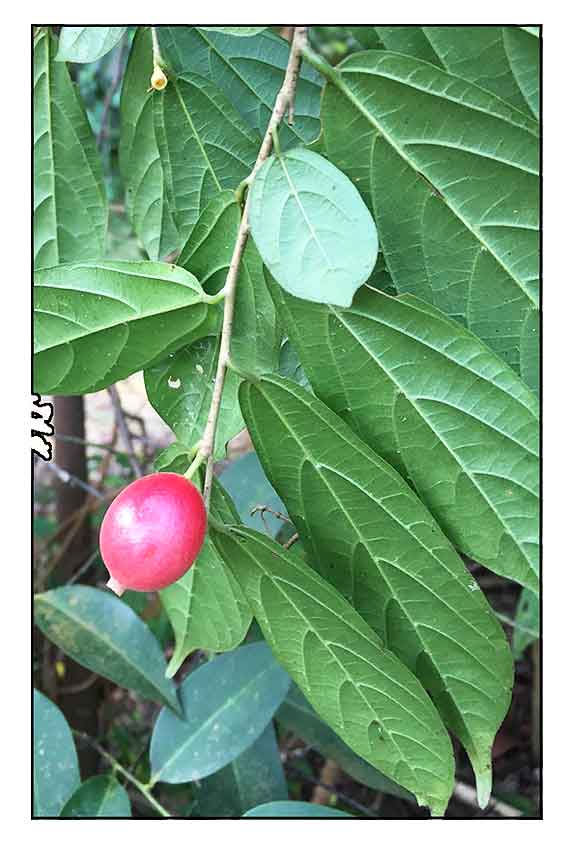 Gen info Gen info
- Alangium is a small genus of flowering plants, included either in a broad view of the dogwood family Cornaceae, or as sole member of its own family Alangiaceae. Alangium contains about 40 species, but some species boundaries are not clear.
- Etymology: The genus name Alangium is a Latinization, derived from the Malayalam name alangi. (3) The specific epithet longiflorum derives from Latin , meaning "long flowers". (4)
- Malatapai was listed as a Threatened Philippine Plant under DENR Administration Order No. 2017-11.
Botany
Alangium longiflorum is a mid-canopy tree up to 35 m tall and 72 cm dbh. Bark is smooth, usually dark brown. Twigs and leaves hairy. Stipules absent. Leaves alternate, simple, tripli-veined, base sometimes conspicuously oblique. Flowers white, ca. 20 mm in diameter, placed in small panicles in leaf axils, long and narrow petals curved downward, exposing stamens. Fruits are ellipsoid to ovoid, ca. 17 mm in length, red to blackish colored fleshy drupes. (4)
 Distribution Distribution
- Native to the Philippines.
- Also native to Borneo, Malaya, Maluku, New Guinea, Sumatera.
(2)
- In forests, from sea level to 1,500 m altitude; sometimes along rivers, on hillsides and ridges.
- Red List of Threatened Species: In 1998 listed as vulnerable.
Constituents
- Phytochemical study of crude extract of leaves isolated 17 secondary metabolites, including two new tetrahydroisoquinoline alkaloids, 8-hydroxytubulosine (1) and 2′-O-trans-sinapoylisoalangiside (2), as well as a new sinapolyloxylupene derivative (3) and 14 known compounds, isoalangiside (4), 2′-O-trans-sinapoyldemethylalangiside (5), 2′-O-trans-sinapoyl-3-O-demethyl-2-O-methylalangiside (6), 2′-O-trans-sinapoylalangiside (7), alangiside (8), demethylalangiside (9), 3-O-demethyl-2-O-methylalangiside (10), 2′-O-trans-feruloyldemethylalangiside (11), 9-demethyltubulosine (12), ankorine (13),
α-tocopherylquinone (14), loganic acid (15), methyl pheophorbide a (16), and pheophytin a (17) (see study below) (5)
- Phytochemical screening of leaf extract yielded terpenoids, alkaloids, phenols, cardiac glycosides and tannins. (see study below)
(6)
- Emetine, a cytotoxic alkaloid, 2-{3-ethyl-10-hydroxy-9-methoxy-1H,2H,3H,4H,6H,7H,11bH-pyrido[2,1-a]isoquinolin-2-yl}acetaldehyde) is found in A. longiflorum.
Properties
- Studies have suggested cytotoxic, antiproliferative, anticancer properties.
Parts used
Leaves, stem bark.
Uses
Edibility
- Fruits are edible. (11)
Folkloric
- No reported folkloric medicinal use in the Philippines.
- In India, leaf juice used for treatment of scabies and skin itching. (9)
Others
- Wood: Used for house construction (beams, flooring, general framing, paneling), furniture and cabinetry, tool handles, walking sticks, handicrafts, gunstock, rice pestles, various other handicrafts. Root wood used to make tobacco pipes.
- Fish poison: In Manipur, India, use to stupefy fish; crushed leaves fermented overnight or two to make to poison stronger. (9)
Studies
• Antiproliferative Alkaloids / Leaves: Phytochemical study of crude extract of leaves isolated 17 secondary metabolites, including two new tetrahydroisoquinoline alkaloids, 8-hydroxytubulosine (1) and 2′-O-trans-sinapoylisoalangiside (2), as well as a new sinapolyloxylupene derivative (3). Compound 1 exhibited broad spectrum inhibitory activity at submicromolar levels against most tested cell lines, except for drug-transporter-overexpressing cells. Compound 1 caused accumulation of sub-G1 cells with no effect on cell cycle progress, suggesting it is an apoptosis inducer. (5)
• Anticancer / Apoptosis in A549 Lung Cancer Cells / Leaves: Study evaluated the cytotoxic activity of A. longiflorum leaf extract against lung cancer cells and compared its pro-inflammatory and cardiotoxic side effects with those of DOX (doxorubicin). The leaf extract exhibited high cytotoxic activity against A549 versus MCF-7. The extract induced apoptosis through activation of caspase-3/7 and upregulation of pro-apoptotic genes without causing NFkB transcriptional activation and nuclear localization. Results suggested potential as apoptotic agent towards lung cancer without inducing significant cardiotoxicity. (see constituents above) (6)
• Cytotoxic Alkaloids / Anticancer Against A549 and MCF-7 / Stem Bark: Study of stem bark isolated seven alkaloids. Compound 1, (-)-10-O-demethylisocephaeline, was isolated for the first time. Compound 2, 10-O-demethylcephaeline, exhibited potent cytotoxic activity against human lung carcinoma (A549) and breast adenocarcinoma (MCF-7) with ED50s of 0.013 and 0.062 µM, respectively. Results suggest compound 2 has potential as cytotoxic lead for further study. (7)
• Inhibitory Tubulosines in Human Glioma Cells: A crude organic solvent extract of Alangium cf. longiflorum exhibited potent inhibition of hypoxia-induced HIF-1 transcriptional activity in human U251 glioma cells. Bioactivity-guided fractionation isolated tubulosine (1), 9-desmethyltubulosine (2), and isotubulosine (3). Tubulosine (1) strongly inhibited HIF-transcriptional activity, while compound 3 was devoid of activity, and compound 2 possessed 6-fold less potency than tubulosine. (8)
Availability
Wild-crafted.
|

![]()





